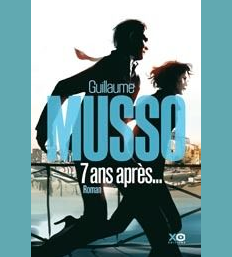7 ans après by Guillaume Musso
This book is considerably longer than the first four I read this summer at nearly 500 pages, so it took me a bit longer to make it to a reflection blog post! During my AP French class last year, I assigned the book Et si c’était vrai… by Marc Levy for students to read on their own time and I wrote a 10 question multiple choice quiz modeled after the AP exam QCM for each chapter. My colleague teaching AP Spanish had had good success with a similar activity, so I tried to make it my own. When I started reading 7 ans après I was originally excited that the first few chapters lined up so neatly with the AP themes! Then I was worried that I would have to switch independent reading books for next year and write new quizzes… But not to worry! While the first chapters are super for the AP themes that I will show you, the rest of the book is just for fun, and even though I might make the switch to a new AP book in a year or two, I feel comfortable sticking with Levy for at least another two semesters. Writing QCM took almost all of my brainpower, so I’m very much looking forward to reducing my workload a bit for the next school year!
I’ve read just one other of Guillaume Musso’s books: La fille de papier and I really liked it so enjoying another of his books was close to a sure thing (I’m also planning to read Que serai-je sans toi this summer, because both were recommended to me). 7 ans après is a fast paced love story/mystery with great descriptions of New York, Paris, and parts of Brazil. For once in my life, I was able to figure out a main plot point before the author explained it clearly to me and I felt a great sense of satisfaction, but I didn’t understand everything until the end! I would highly recommend this book to read in its entirety for both teachers and students. However, if you’d like to use some smaller sections in class, here’s what I would do:
Chapter 1: To begin the book, we meet Camille and Sebastian Larabee who live in an affluent neighborhood in New York City. Camille, 15 years old, goes out for a jog and her father, Sebastian, searches her room under the pretense of keeping his daughter out of trouble. He uses some different technology tricks to track Camille’s activities and I would use this chapter as a springboard to discuss ethics in the science and technology theme. When Sebastian discovers Camille’s birth control pills, students would have the chance to dovetail the discussion to cover family and community issues as well! While Camille is a bit young to be a direct contemporary of most AP French students, her age is close enough to help them share some personal insight during the discussion.
Chapter 2: Sebastian confronts Camille with what he has found in her bathroom and this leads nicely into further exploration of the family and community theme. The way that both of the players react to each other can be seen as somewhat typical parent-adolescent dispute that can lead students to talk about similar experiences in their own lives.
Chapter 3: The second half of the chapter lends itself well to the esthetics theme, presenting history and vocabulary associated with violin making. Students could share their musical experiences and perhaps share a favorite song with the class while pointing out what they find beautiful or esthetically pleasing about the lyrics or melody. I would also like to know what, if any, experience students have with classic music and training and because Stromae is going to be in Atlanta in September, maybe we could all buy tickets to see his concert together!
Chapter 4: The beginning of this chapter deals with love, marriage, divorce, and children to continue the work on the family and community theme. I would read this excerpt with my students along with part of chapter 48 to discuss their own experiences with these concepts. There is a conversation in chapter 48 between another child, Jeremy, and his therapist that deals with his relationship with each parent and how their divorce affected him. It’s a bit reminiscent of The Parent Trap, certainly worth discussing in the target language with my AP students.
There are plenty of other aspects of the book that would be valuable in an AP setting, but those chapters I’ve mentioned are most specifically tailored to the themes of the exam. As I consider working these passages into my AP curriculum, I wonder if it wouldn’t be a better idea to introduce these chapters to my juniors in French IV instead. We already have a decent AP French textbook that’s full of selected readings and premade questions/vocabulary lists. Perhaps I’ll take these excerpts and write my own questions and vocabulary exercises plus a few QCM to introduce my rising seniors to AP level work! And if any of the lessons turn out particularly well, I can certainly incorporate them into the AP themes with my seniors.
How do you enhance your own curriculum with authentic resources? I would love to know!






